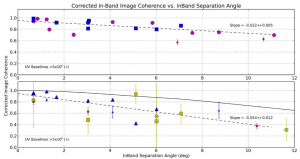Based on Extension of Capabilities (EOC) observations made in late 2017, the high-frequency long-baseline (HF-LB) team have recently published work detailing their extensive tests (please see the full article here). The main aim of the work was to compare standard phase referencing, defined as In-Band, with the band-to-band (B2B) technique. The latter technique allows the observatory to calibrate data using a phase calibrator observed at a lower frequency than the target source. The practical reason for B2B is that at higher and higher observing frequencies, quasars, used as phase calibrators become weaker and therefore a sufficiently bright one will often be at a large separation from the science target. This can result in less optimal calibration and imaging, something the team also aimed to clarify. To achieve their aims, the HF-LB team made observations in the In-Band and B2B modes where the modes shared the same close calibrators (within 2 deg of the targets), but also in cases where the In-Band calibrators were chosen to be further away, up to a maximal value of ~11 deg.
Comparing B2B and In-Band phase referencing and Calibrator separation angles.

The main results reported were: (1) The extra calibration required to solve the difference between high- and low-frequency bands, so called differential-gain-calibration (DGC), for B2B mode produces a coherence loss of <7% provided DGC phase residuals are <30deg RMS when comparing with In-Band observations with the same calibrators. (2) B2B images using calibrators <1.7deg are generally superior to In-Band images using calibrators more distant than 2.4 to 11.6 deg. Although the DGC causes some coherence loss in B2B mode, the distant calibrators for In-Band have a similar or worse effect. (3) Overall, B2B observations are preferred if they can provide a calibrator 2deg closer than the In-Band calibrator. (4) Image coherence and phase calibration quality decrease was a function of increasing calibrator distance, due to sub-optimal phase correction for a different line-of-sight between targets and calibrators, and due to antenna position uncertainties. The antenna position uncertainties are directly related to frequency, and baseline length - higher and longer being worse, respectively. (5) To achieve >70% image coherence for 16km baseline observation in band 7, the maximal phase calibrator -to- target separation angle should be within ~4deg.
The team also made projections toward even higher frequencies (>400GHz) with long-, 16km, baselines, and report that is might be difficult to obtain high quality images unless very close calibrators within 1-2deg can be used. For more information please see the full article here .
Figure: Corrected In-Band image coherence compared with In-Band calibrator separation angle. Top and bottom are for visibility baselines below, and above 5000k lambda (~5000m at band 7), in order to equally compare different frequencies. The dashed lines are linear fits to the data. For shorter baselines the trend is shallow, while it is much steeper for longer baselines. The solid line in the bottom plot shows the coherence loss due to only antenna position uncertainties. As the fit to the data is worse, it can be realised that phase-calibration is sub-optimal with larger separation angles, and does not fully correct for different lines-of-sight between the target and calibrator. Blue, purple and yellow symbols are band 7, 8 and 9, while circles show maximal baselines between 2.0-3.7km, squares between 3.7 and 8.5km and triangles for 8.5-12.0km

